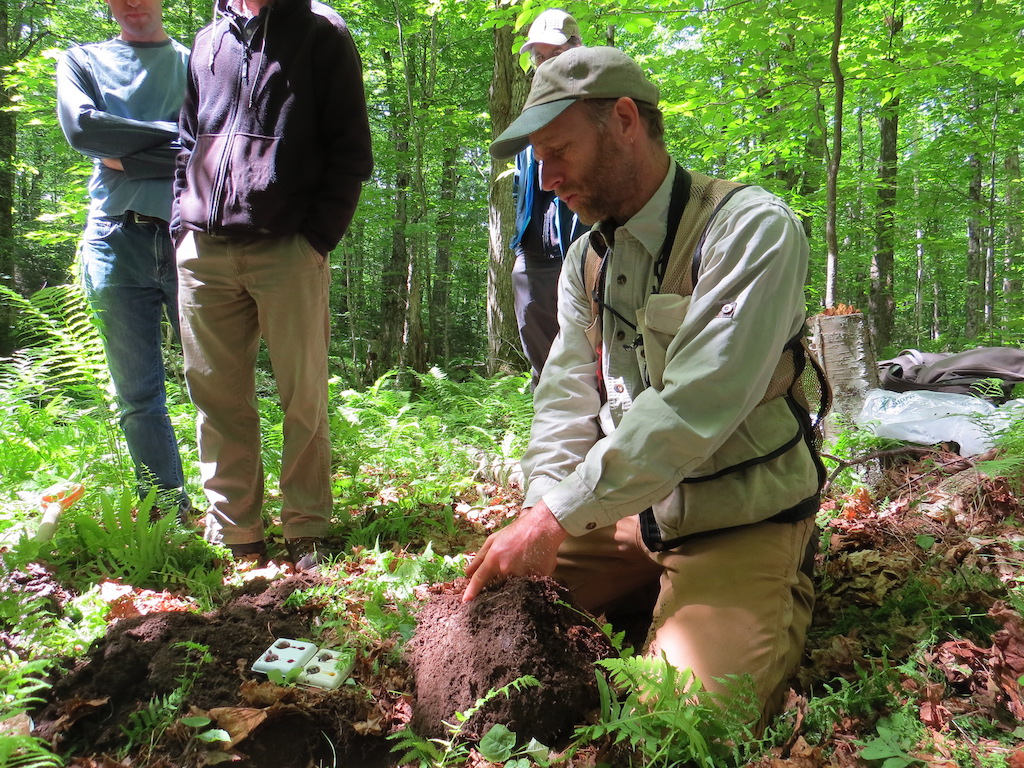
The deer mouse clung tight to the inside of the metal trap, but a firm shake from mammal researcher Nick Tepper loosened his grip, and he dropped into a small laundry bag. Nick scruffed the mouse’s neck through the mesh fabric, careful to avoid the sharp incisors. He held the mouse high as he walked around the circle of landowners who had gathered to learn about forest biodiversity.

The mouse was one of several small mammals Nick had trapped over the past few days, in anticipation of this morning’s gathering—a special workshop offered by Vermont Family Forests (VFF) to the forest landowners the organization works with.
In the workshop, What’s Alive in the Forest?, landowners explored VFF’s “Abraham’s Knees” forest in Lincoln through the eyes, ears, and expertise of Marc Lapin (botany and ecosystems), Barry King (birds), Jim Andrews (reptiles and amphibians), Nick Tepper (small mammals), Greg Borah (wildlife tracking), and Kristen Underwood (hydrology).
All six researchers are part of VFF’s Colby Hill Ecological Project (CHEP), an on-going research project that has monitored ecological processes and biodiversity on 710 acres of private land in Lincoln since 1998. Lester and Monique Anderson, who initiated and funded CHEP on their land, bequeathed the land and project to VFF in 2016.
During Saturday’s workshop, the wildlife researchers (Barry, Jim, Greg, and Nick) described how they go about monitoring wildlife for CHEP and how landowners can explore and encourage wildlife biodiversity in their own forest land.
Barry tuned our ears to the cadences of forest birds, and we heard 23 different species during our morning outing. Part of the beauty of the day was experiencing the cumulative, overlapping knowledge and enthusiasm of the researchers, as they recalled favorite mnemonics for remembering bird songs, pondered tricky songs together, and generally shared their exuberance for the natural world.

Nick and Greg each shared their expertise in observing and identifying mammals—Nick through live-trapping and observation, and Greg through tracking. Greg described how tracking involves attuning to forest patterns and noticing changes in those patterns—tracks, broken or nipped twigs, nests, claw marks in bark, and so on—as happens when an animal passes through.
Jim and Nick scrambled along a little stream that flowed through a wet depression in the land, and emerged with an American toad, wood frog, eastern red-backed salamander, northern dusky salamander, and northern two-lined salamander. Jim described how to construct cover-boards and snake-covers—as he does for his CHEP research—to attract salamanders and snakes. He spoke about the importance of buffering wetlands like this one from any tree cutting and road building to safeguard wildlife.
A forest community is only as healthy as the soil it’s rooted in. CHEP team leader Marc Lapin dug into forest soils to show landowners how pH and soil structure varies in the forest, and how those soil characteristics affect the forest’s plant communities. Kristen Underwood further explored how the forest’s topography affects the flow of water over land, and how such forest practices as building access paths and cutting trees impact the land’s hydrology.

Our reason for being at Vermont Family Forests is help people connect more deeply with the forests of home and interact with these forests in a way that puts their health and wholeness first. In workshops like this one, we are guided by the idea of learning from the forest, rather than learning about it, as author Robin Wall Kimmerer puts it.
We learned a bundle from the forest on Saturday. We met some of the many wild members of this beautiful piece of land, which VFF purchased in December as a place to walk the talk of conservation forestry, and we look forward to meeting many more as the years go by.
If you weren’t able to be there on Saturday, don’t worry—we’ll surely be having more workshops like this one. Looking forward to seeing you in the forest sometime soon.





